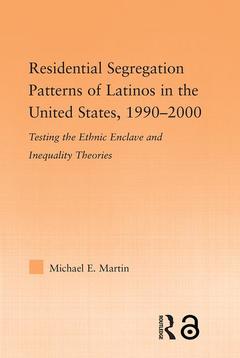Residential Segregation Patterns of Latinos in the United States, 1990-2000 Latino Communities: Emerging Voices - Political, Social, Cultural and Legal Issues Series
Auteur : Martin Michael E

Historically, residential segregation of Latinos has generally been seen as a result of immigration and the process of self-segregation into ethnic enclaves. The only theoretical exception to ethnic enclave Latino segregation has been the structural inequality related to Latinos that have a high degree of African ancestry. This study of the 331 metropolitan area in the United States between 1990 and 2000 shows that Latinos are facing structural inequalities outside of the degree of African ancestry. The results of the author's research suggest that Latino segregation is due to the mobility of Latinos and structural barriers in wealth creation due to limited housing equity and limited occupational mobility. In addition, Latino suburbanization appears to be a segregation force rather than an integration force. This study also shows that Mexicans, Puerto Ricans and Cubans have different experiences with residential segregation. Residential segregation of Cubans does not appear to be a problem in the U.S. Puerto Ricans continue to be the most segregated Latino sub-group and inequality is a large factor in Puerto Rican segregation. A more in-depth analysis reveals that the Puerto Rican experience is bifurcated between the older highly segregated enclaves where inequality is a large problem and new enclaves where inequality and segregation are not an issue. The Mexican residential segregation experience reflects that immigration and mobility are important factors but previous theorists have underestimated the barriers Mexicans face in obtaining generational wealth and moving from the ethnic enclave into the American mainstream.
I. Introduction to Latino Residential Segregation II. Why Do We Need to Study Latino Residential Segregation III. What Has Research on Residential Segregation Told Us So Far? IV. Sources of Data and Methodology V. Extent of Latino Segregation VI. Extent of Latino Sub-Group Segregation VII. Causes of Latino Segregation VIII. Causes of Latino Sub-Group Segregation IX. Summary, Conclusions & Policy Implications Appendix 1: Index of Isolation 1890–1930 Appendix 2: Univariate Analysis of (D) Scores 1970–2000 Appendix 3: Latino Residential Segregation in 2000 Appendix 4: Regression Model for Latinos and Blacks: Demographics; Socio-Economics Appendix 5: Regression Model for Latinos and Blacks: Demographics & Socio-Economics Appendix 6: Regression Model for Mexicans, Puerto Ricans and Cubans: Demographics; Socio-Economics Appendix 7: Regression Model for Mexicans, Puerto Ricans and Cubans: Demographics & Socio-Economics
Date de parution : 02-2007
15.2x22.9 cm
Date de parution : 04-2015
Ouvrage de 144 p.
15.2x22.9 cm
Disponible chez l'éditeur (délai d'approvisionnement : 14 jours).
Prix indicatif 53,83 €
Ajouter au panierThème de Residential Segregation Patterns of Latinos in the... :
Mots-clés :
Latino Segregation; sub-groups; Latino Sub-groups; ethnic; Highly Segregated; enclave; Ethnic Enclave; puerto; Residential Segregation; rican; Regression Model; rates; Segregation Rates; metropolitan; Puerto Rican; area; Latino Subgroups; highly; Central City; segregated; Suburbanization Rate; Ethnic Enclave Theory; Housing Equity; Immigrant Hub; Segregated Central City; Central City Areas; Place Stratification Model; Socio-economic Variables; Black Segregation; Suburban Segregation; Individual Metropolitan Areas; Caribbean Latinos; Segregation Patterns; Metropolitan Areas; Census



